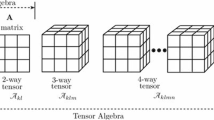Abstract
In this paper, we propose a fast and robust face recognition method named enhancing sparsity via full rank decomposition. The proposed method first represents the test sample as a linear combination of the training data as the same as sparse representation, then make a full rank decomposition of the training data matrix. We obtain the generalized inverse of the training data matrix and then solve the general solution of the linear equation directly. For obtaining the optimum solution to represent the test sample, we use the least square method to solve it. We classify the test sample into the class which has the minimal reconstruction error. Our method can solve the optimum solution of the linear equation, and it is more suitable for face recognition than sparse representation classifier. The extensive experimental results on publicly available face databases demonstrate the effectiveness of the proposed method for face recognition.












Similar content being viewed by others
References
Howland P, Wang J, Park H (2006) Solving the small sample size problem in face recognition using generalized discriminant analysis. Pattern Recogn 39:277–287
Xu Y, Zhang D, Jin Z, Li M, Yang J-Y (2006) A fast kernel-based nonlinear discriminant analysis for multi-class problems. Pattern Recogn 39:1026–1033
Lai ZH, Wong WK, Jin Z, Yang J, Xu Y (2012) Sparse approximation to the eigensubspace for discrimination. IEEE Trans Neural Netw Learn Syst 23:1948–1960
Jiang X, Mandal B, Kot A (2008) Eigenfeature regularization and extraction in face recognition. IEEE Trans Pattern Anal Mach Intell 30:383–394
Xu Y, Zhang D, Yang J-Y (2010) A feature extraction method for use with bimodal biometrics. Pattern Recogn 43:1106–1115
Belhumeur PN, Hespanha J, Kriegman DJ (1997) Eigenfaces vs. Fisherfaces: recognition using class specific linear projection. IEEE Trans Pattern Anal Mach Intell 19:711–720
Turk M, Pentland A (1991) Eigenfaces for recognition. J Cogn Neurosci 3:71–86
Roweis S, Saul L (2000) Laplacian eigenmaps and spectral techniques for embedding. Science 290:2323–2326
He XF, Yan SC, Hu YX, Niyogi P, Zhang HJ (2005) Face recognition using laplacianfaces. IEEE Trans Pattern Anal Mach Intell 27:328–340
Levin A, Shashua A (2002) Principal component analysis over continuous subspaces and intersection of half-spaces. In: Proceedings of European conference computer vision. Springer, Berlin
Fan ZZ, Xu Y, Zhang D (2011) Local linear discriminant analysis framework using sample neighbors. IEEE Trans Neural Netw 22:1119–1132
Yang J, Zhang D, Frangi AF, Yang J (2004) Two-dimensional PCA: a new approach to appearance-based face representation and recognition. IEEE Trans Pattern Anal Mach Intell 26:131–137
Zhou T, Tao D, Wu X (2011) Manifold elastic net: a unified framework for sparse dimension reduction. Data Min Knowl Disc 22:340–371
Ji S, Xue Y, Carin L (2008) Bayesian compressive sensing. IEEE Trans Signal Process 56:2346–2356
Poggio T, Girosi F (1998) A sparse representation for function approximation. Neural Comput 10:1445–1454
Wright J, Ma Y, Mairal J, Sapiro G, Huang T, Yan S (2010) Sparse representation for computer vision and pattern recognition. Proc IEEE 98:1031–1044
Wright J, Yang AY, Ganesh A, Sastry SS, Ma Y (2009) Robust face recognition via sparse representation. IEEE Trans Pattern Anal Mach Intell 31:210–227
Duda R, Hart P (2001) and D. Stork. Pattern Classification, second ed. John Wiley & Sons
Ho J, Yang M, Lim J, Lee K, Kriegman D (2003) Clustering appearances of objects under varying illumination conditions. Proceedings of the IEEE international conference computer vision and pattern recognition, pp 11–18
Gao S, Tsang I, Chia L-T (2010) Kernel sparse representation for image classification and face recognition. In: ECCV
Elhamifar E, Vidal R (2009) Sparse subspace clustering. In: CVPR
He R, Zheng W-S, Hu B-G, Kong X-W (2011) Nonnegative sparse coding for discriminative semi-supervised learning. In: CVPR
Yang M, Zhang L, Yang J, Zhang D (2011) Robust sparse coding for face recognition. In: CVPR
Guo S, Wang Z, Ruan Q (2013) Enhancing sparsity via l p(0<p<1) minimization for robust face recognition. Neurocomputing 99:592–602
Donoho D (2006) For most large underdetermined systems of linear equations the minimal l 1-norm solution is also the sparsest solution. Commun Pure Appl Math 59:797–829
Cande’s E, Romberg J, Tao T (2006) Stable signal recovery from incomplete and inaccurate measurements. Commun Pure Appl Math 59:1207–1223
Cande’s EJ, Wakin M, Boyd S (2008) Enhancing sparsity by reweighted l 1 minimization. J Fourier Anal Appl 14:877–905
Zhang L, Yang M, Feng XC (2011) Sparse representation or collaborative representation: which helps face recognition? In: ICCV
Samaria S, Harter AC (1994) Parameterisation of a stochastic model for human face identification. In Proceedings of the 2nd IEEE international workshop applications of Computer Vision, Sarasota, FL
Martinez A, Benavente R (1998) The AR face database, CVC technical report 24
Phillips PJ, Moon H, Rizvi SA, Rauss PJ (2000) The FERET evaluation methodology for face-recognition algorithms. IEEE Trans Pattern Anal Mach Intell 22:1090–1104
Kim MY (2013) Accelerated max-margin multiple kernel learning. Appl Intell 38:45–57
Hoyer PO (2004) Nonnegative matrix factorization with sparseness constraints. J Mach Learn Res 5:1457–1469
Acknowledgments
This article is partly supported by the Natural Science Foundation of China (Grant Nos. 61203376, 61375012, 61263032, and 61362031), the General Research Fund of Research Grants Council of Hong Kong (Project No. 531708), the China Postdoctoral Science Foundation under Project 2012M510958 and 2013T60370, the Guangdong Natural Science Foundation under Project S2012040007289, and Shenzhen Municipal Science and Technology Innovation Council (Nos. JC201005260122A, JCYJ201206 13153352732 and JCYJ20120613134843060, JCYJ20130329152024199).
Author information
Authors and Affiliations
Corresponding author
Rights and permissions
About this article
Cite this article
Lu, Y., Cui, J. & Fang, X. Enhancing sparsity via full rank decomposition for robust face recognition. Neural Comput & Applic 25, 1043–1052 (2014). https://doi.org/10.1007/s00521-014-1582-4
Received:
Accepted:
Published:
Issue Date:
DOI: https://doi.org/10.1007/s00521-014-1582-4




